Material Transmitted:
Department of Health and Human Services (HHS) Instruction 610-1, Establishing and Administering Hours of Duty, dated December 2, 2021.
Material Superseded:
HHS Instruction 610-1, Establishing and Administering Hours of Duty, dated 05/16/2008
Background:
This Instruction establishes Departmental policy on hours of duty and clarifies roles and responsibilities for administering hours of duty within the Department. This Instruction has been revised to address Alternative Work Schedules.
This policy is effective immediately and must be carried out by HHS Operating and Staff Division Heads in accordance with applicable laws, regulations, bargaining agreements, and Departmental policy.
/s/
Michael V. Culpepper
Deputy Assistant Secretary for Human Resources and Chief Human Capital Officer, Acting
610-1-00 Sections
610-1-10 Purpose
610-1-20 Coverage and Exclusions
610-1-30 References
610-1-40 Definitions
610-1-50 Responsibilities
610-1-60 Policy
610-1-70 Documentation and Accountability
610-1-10 Purpose
This Instruction implements the Department of Health and Human Services (HHS) policy on the establishment of workweeks, work schedules, and related matters in order for HHS to plan and schedule work consistent with the actual work requirements needed to accomplish its mission.
When provisions of this policy differ from changes in applicable law or regulation, the changes in law or regulation apply.
610-1-20 Coverage and Exclusions
- Coverage.
The provisions of this Instruction apply to all HHS employees including Federal Wage System employees.
- Exclusions.
- Members of the Senior Executive Service (SES);
- U.S. Public Health Service (PHS) Commissioned Corps Officers
- When the provisions of this Instruction differ from the requirements contained in applicable collective bargaining agreement(s), the collective bargaining agreement takes precedence for bargaining unit employees.
610-1-30 References
- Executive Order 11582 (Observance of Holidays by Government Agencies, February 11, 1971)
- 5 U.S.C. §§ 6101-6133 (Hours of Work)
- 5 C.F.R. Part 610 (Hours of Duty)
- 5 C.F.R. Part 630 (Absence and Leave)
- HHS Instruction 630-1 (Leave and Excused Absences), issued December 17, 2010
- HHS Guide for Timekeeping, October 2018
610-1-40 Definitions
- Administrative Workweek. Any period of seven (7) consecutive 24-hour periods as designated in advance by the Secretary or his/her designee(s). See 610-1-60 below.
- Alternative Work Schedule (AWS). Refers to flexible and compressed work schedules.
- Basic Work Requirement. The number of hours, excluding overtime hours, an employee is required to work or to account for by leave or otherwise.
- Compressed Work Schedule (CWS). For full-time employees, an 80-hour biweekly basic work requirement which is scheduled for less than 10 workdays. For part-time employees, a biweekly basic work requirement of less than 80 hours which is scheduled for less than 10 workdays.
- Core Hours. The designated hours and days during which an employee on a flexible work schedule must be present for work, as designated by the Operating Divisions/Staff Divisions (OpDiv/StaffDivs) Heads.
- Credit Hours. For employees on a flexible work schedule, any hours that an employee elects to work in excess of his or her basic work requirement so as to vary the length of a workweek or workday. Full time employees on a flexible work schedule may accumulate not more than 24 credit hours, and part-time employees may accumulate not more than one-fourth (1/4) of the hours in their bi-weekly basic work requirement, for carryover from a biweekly pay period to a succeeding biweekly pay period. Credit hours in excess of 24 hours are forfeited and do not entitle the employee to overtime compensation. Credit hours may not be earned or used by employees working under a compressed schedule.
- Flexible Work Schedule (FWS). A work schedule which includes both 1) core hours; and 2) designated hours during which an employee may elect the time of such employee’s arrival at and departure from work as designated by OpDiv/StaffDivs.
- Overtime Hours. When used with respect to FWS programs, all hours in excess of 8 hours in a day or 40 hours in a week which are officially ordered in advance, but does not include credit hours. With respect to full-time employees in CWS programs, any hours worked in excess of those specified hours which constitute the compressed work schedule. With respect to part-time employees in CWS programs, overtime pay shall begin to be paid after the same number of hours of work after which a full-time employee on a similar schedule would begin to receive overtime pay. Refer to HHS Instruction 550-1, “Premium Pay.”
- Regularly Scheduled Administrative Workweek. For full-time employees, it is the period within an administrative workweek within which an employee is regularly scheduled to work. For part-time employees, it is the officially prescribed days and hours within an administrative workweek during which an employee is regularly scheduled to work.
- Regularly Scheduled Work. Work that is scheduled in advance of an administrative workweek.
- Tour of Duty. The hours of a day (a daily tour of duty) and the days of an administrative workweek (a weekly tour of duty) that constitute an employee’s regularly scheduled administrative workweek.
610-1-50 Responsibilities
- HHS Assistant Secretary for Administration, Office of Human Resources (ASA/OHR):
- Develops Department-wide human resources guidance and policy consistent with HHS and OPM policy, procedures and all applicable federal laws and regulations.
- Periodically reviews Operating Division and Staff Division (OpDiv/StaffDiv) procedures to assure conformance with HHS and OPM policy and guidance, and all applicable federal laws and regulations.
- OpDiv/StaffDiv Heads (reference in this document to action by OpDiv/StaffDivs means the OpDiv/StaffDiv Heads):
- Comply with this Instruction, and applicable federal laws and regulations.
- Designate core hours for their respective OpDiv/StaffDivs.
- Establish and publish supplemental policy on the regularly scheduled administrative workweek for full-time employees that includes a 40-hour basic workweek consisting of five (5) consecutive, 8-hour days, including the hours of duty.
- When it is impracticable to prescribe a regular schedule of definite hours of duty for each workday of a regularly scheduled administrative workweek, OpDiv/StaffDivs may establish the first 40 hours of duty performed within a period of not more than 6 days of the administrative workweek as the basic workweek. A first 40-hour tour of duty is the basic workweek without the requirement for specific days and hours within the administrative workweek. All work performed by an employee within the first 40 hours is considered regularly scheduled work for premium pay and hours of duty purposes. Any additional hours of officially ordered or approved work within the administrative workweek are overtime work. See 5 C.F.R. 610.111(b) and HHS Instruction 550-1, “Premium Pay.”
- Ensure that regularly scheduled overtime is used prudently and that it is requested in writing and approved in advance of the administrative workweek, where practicable.
- Track and record hours worked, leave usage, overtime, credit hours, compensatory time and other forms of paid and non-paid duty status.
- Authorize variations in work schedules for educational purposes and other circumstances consistent with mission objectives and applicable laws and regulations.
- Approve, modify, or terminate alternative work schedules in accordance with laws, regulations, HHS policy and applicable collective bargaining agreements.
- Supervisors and Managers:
- Approve or modify individual employee work schedules based on their assessment of the needs of the office and each employee's conduct and performance, and in order to accommodate, whenever reasonable and practicable, the employee's preferred arrival and departure times. Supervisors monitor staff attendance and work practices to determine the impact of the staff schedules on the functioning of the office. As a result of such monitoring or assessments, supervisors may restrict, modify, or cancel an employee's participation in AWS.
- Direct changes in work schedules or modifications when necessary to meet operational needs of the organization or when the employee deviates from his or her approved work schedule.
- Ensure requests for changes in work schedules are approved in a fair and equitable manner.
- Employees
- Report to work on time and adhere to the stipulated hours and days of work in accordance with their approved work schedule.
- Understand performance standards and abide by rules of conduct which factor into decisions associated with alternative work schedules.
610-1-60 Policy
- Weekly and Daily Scheduling of Work.
- Basic Workweek
- HHS shall observe an administrative workweek that consists of seven (7) consecutive calendar days which run from 12:01 a.m. Sunday to 12:00 midnight Saturday.
- The basic workweek, for full-time employees, shall consist of 40-hours over five (5) consecutive days.
- The regularly scheduled administrative workweek shall be from Monday through Friday, eight (8) hours per day with two consecutive days off on Saturday and Sunday.
- The official hours of duty during the basic workweek are from 8:30 a.m. to 5:00 p.m., which includes a 30-minute meal break that is generally taken between 11:00 a.m. and 2:00 p.m., except as otherwise provided within the respective collective bargaining agreement. The meal break must be taken daily and cannot be forgone in order to shorten the daily tour of duty, unless an exception is approved by an authorized management official. OpDiv/StaffDivs may vary the official hours of duty, the length of the meal break, and the timeframe during which meal breaks may be taken based on mission requirements and consistent with applicable law, regulations, HHS policies and applicable collective bargaining agreements.
- Under 610-1-50(B) above, OpDiv/StaffDivs may prescribe certain exceptions to the basic workweek.
- Basic Workweek
- Types of Alternative Work Schedules
- Compressed Work Schedule. In the case of a full-time employee, an 80-hour biweekly basic work requirement that is scheduled for less than 10 workdays. In the case of a part-time employee, a biweekly basic work requirement of less than 80 hours that is scheduled for less than 10 workdays. Employees on a Compressed Work Schedule are not entitled to credit hours.
OpDiv/StaffDivs are responsible for establishing the CWSs available for their OpDiv/StaffDivs and may choose to establish either, or both, or none of the following available CWS options:
- Five day/four day compressed plan (5-4/9)
- A full-time employee works eight 9-hour days and one 8-hour day for a total of 80 hours in a biweekly pay period. The employee has one (1) day off each biweekly pay period. The OpDiv/StaffDiv determines the number of hours each day a part-time employee must work in a 9-day biweekly pay period.
- Four-day Work Week (4/10)
- In the case of a full-time employee who works a four-day workweek, the employee must work 10 hours a day, 40 hours a week and 80 hours in a biweekly pay period. In the case of a part-time employee who works a four-day workweek, the OpDiv/StaffDivs will determine the number of hours each day a part-time employee must work in a four-day workweek and the number of hours in a biweekly pay period.
- Five day/four day compressed plan (5-4/9)
- Flexible Work Schedule. In the case of a full-time employee, has an 80-hour biweekly basic work requirement that includes both 1) core hours; and 2) designated hours during which the employee may elect the time of such employee’s arrival at and departure from work. In the case a part-time employee, has a biweekly basic work requirement of less than 80 hours that includes both 1) core hours; and 2) designated hours during which the employee may elect the time of such employee’s arrival at and departure from work. For both full-time and part-time employees, the OpDiv/StaffDivs shall designate both 1) the core hours; and 2) the hours during which employees may elect to arrive at and depart from work. Employees on a flexible work schedule are entitled to credit hours.
OpDiv/StaffDivs are responsible for establishing the FWSs available for their OpDiv/StaffDivs and may choose to establish one, two, three, or all of the following available options, or may choose not to establish any of the following options:- Gliding Schedule: A type of flexible work schedule in which a full-time employee has a basic work requirement of 8 hours in each day and 40 hours in each week, and may select a starting and stopping time each day, and may change starting and stopping times daily within the established flexible hours. For example:
Image

- Flexitour Schedule. A type of flexible work schedule in which an employee is allowed to select starting and stopping times within the flexible hours. Once selected, the hours are fixed until the OpDiv/StaffDiv provides an opportunity to select different starting and stopping times. For example:
Image
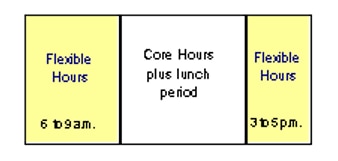
- Variable Week Schedule. A type of flexible work schedule containing core hours on each workday in the biweekly pay period and in which a full-time employee has a basic work requirement of 80 hours for the biweekly pay period, but in which an employee may vary the number of hours worked on a given workday or the number of hours each week within the limits established by the OpDiv/StaffDivs. Below is an example of what a variable week schedule might look like. The basic work requirement is 80 hours and the employee worked 2 credit hours.
Variable Week Schedule - Week 1
Image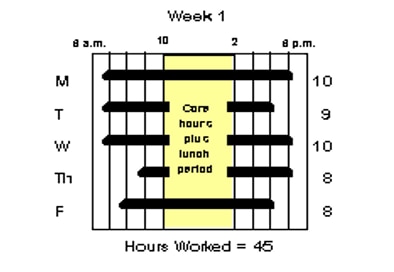
Variable Week Schedule - Week 2
Image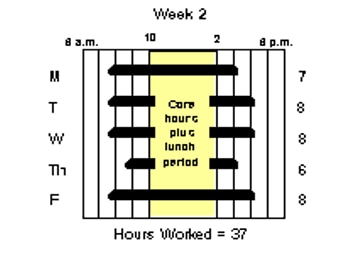
- Maxiflex. A type of flexible work schedule that contains core hours on fewer than 10 workdays in the biweekly pay period, but in which an employee may vary the number of hours worked on a given workday or the number of hours each week within the limits established by the OpDiv/StaffDivs. Below is an example of what a maxiflex schedule might look like. The basic work requirement is 80 hours and the employee worked 2 credit hours.
Maxiflex Schedule
Image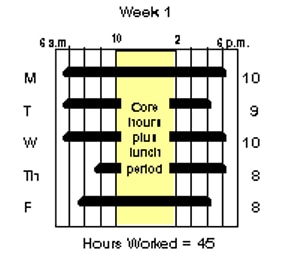
Maxiflex Schedule
Image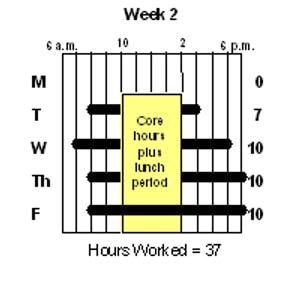
- Gliding Schedule: A type of flexible work schedule in which a full-time employee has a basic work requirement of 8 hours in each day and 40 hours in each week, and may select a starting and stopping time each day, and may change starting and stopping times daily within the established flexible hours. For example:
- Compressed Work Schedule. In the case of a full-time employee, an 80-hour biweekly basic work requirement that is scheduled for less than 10 workdays. In the case of a part-time employee, a biweekly basic work requirement of less than 80 hours that is scheduled for less than 10 workdays. Employees on a Compressed Work Schedule are not entitled to credit hours.
- Leave
- Leave or Other Excused Absence. AWS has no effect on an employee's right to use annual or sick leave. All requirements for the advanced approval of non-emergency leave remain in effect. Responsibilities of employees and supervisors with regard to requesting and approving or disapproving leave, both annual and sick, remain the same. Time off during an employee's basic workweek or AWS must be charged to an appropriate leave category, compensatory time off, credit hours, or other excused absence. Approved leave taken for the entire day will be charged according to the number of hours that would normally have been worked. If an AWS employee uses annual or sick leave on a day the employee was otherwise scheduled to work, the employee must be charged leave for the total number of hours required by the work schedule on that day. Excused absence may be granted to employees on AWS under the same circumstances as with employees on other work schedules. Refer to HHS Instruction 630-1, “Leave and Excused Absence,” for HHS policy on use of leave and excused absence.
- Holidays
- 5 U.S.C. § 6103 and Executive Order 11582 govern the identification and determination of holidays. However, when a holiday, designated as such by Federal statute or Executive order, falls on a regular weekly scheduled non-work day, the day to be treated as a holiday for pay and leave purposes (the “in-lieu-of” holiday) will be determined as follows:
- When a holiday occurs on a Saturday, the Friday immediately before is a legal holiday for employees whose basic workweek is Monday through Friday;
- When the actual holiday falls on a Sunday, the legal holiday will be the following workday (Monday for most employees).
- For an employee whose basic workweek is other than Monday through Friday, when the actual holiday occurs on a regular weekly non-workday, except the regular weekly non-workday administratively scheduled for the employee instead of Sunday, the legal or in-lieu-of holiday is the workday immediately before the actual holiday.
- Part-time CWS and FWS employees are not entitled to an in-lieu-of holiday.
- For federal employees who have duty posts outside the US, and who have a basic workweek other than Monday through Friday, and are regularly scheduled to work on Monday, their legal public (or in-lieu-of) holiday is the first workday of the workweek in which the Monday designated for the observance of the holiday occurs. 5 U.S.C. 6103(b)(3)
- Federal employees in the Washington DC area are entitled to a holiday on the day a President is inaugurated (January 20 following a Presidential election). Employees are entitled to this holiday if they are employed in: District of Columbia, Montgomery and Prince Georges Counties in Maryland; Arlington and Fairfax Counties in Virginia; and the cities of Alexandria and Falls Church in Virginia. Pursuant to 5 U.S.C. § 6103(c), when January 20 “falls on Sunday, the next succeeding day selected for the public observance of the inauguration of the President is a legal public holiday for purpose of” pay and leave.
- Full-Time Employees who are authorized to work a flexible work schedule who are relieved or prevented from working on a day designated as a holiday by Federal statute or Executive order are entitled to pay with respect to that day for eight (8) hours. If the President issues an Executive Order granting a half-day holiday, a full-time employee on a flexible work schedule is credited with half the number of hours he/she was scheduled to work, not to exceed four (4) hours.
- Full-Time Employees who are authorized to work a compressed work schedule and who are relieved or prevented from working on a day designated as a holiday by Federal statute or Executive Order are entitled to basic pay for the number of hours of the compressed work schedule on that day. For example, if an employee is scheduled to work a 9 or 10-hour workday, the employee’s holiday is 9 or 10 hours respectively. If the President authorizes a half-day holiday, a full-time employee on a compressed work schedule is entitled to basic pay for half the number of hours he/she would otherwise work on that day.
- Part-time employees on a flexible work schedule who are relieved or prevented from working on a day within the employee’s scheduled tour of duty that is designed as a holiday by Federal statute or Executive Order, are entitled to receive basic pay with respect to the holiday for the number of hours they are regularly scheduled to work on that day, not to exceed 8 hours.
- Part-time employees on a compressed work schedule who are relieved or prevented from working on a day within their scheduled tour of duty that is designated as a holiday by Federal statute or Executive order are entitled to basic pay for the number of hours of the compressed work schedule on that day.
- Part-time CWS and FWS employees are not entitled to an in-lieu-of day off when a holiday falls on a non-work day for the employee.
- If an employee has two basic workdays (i.e., two basic scheduled tours of duty) that overlap a single holiday, the employee is entitled to a holiday only for the tour of duty that commences (i.e., begins) on the holiday. The entire workday that begins on the holiday must be treated as if it fell on the holiday.
- 5 U.S.C. § 6103 and Executive Order 11582 govern the identification and determination of holidays. However, when a holiday, designated as such by Federal statute or Executive order, falls on a regular weekly scheduled non-work day, the day to be treated as a holiday for pay and leave purposes (the “in-lieu-of” holiday) will be determined as follows:
- Meal Breaks
- A meal break is an approved period of time in a non-pay and non-work status that interrupts a basic workday or a period of overtime work for the purpose of allowing an employee to eat or engage in personal activities. Employees who work five (5) or more hours in a day are allocated a 30-minute meal break. Employees must take a meal break and may not save any part of the thirty (30) minutes in order to leave early or extend subsequent meal periods, unless an exception is authorized by the supervisor or other authorized approving management official.
- At the discretion of OpDiv/StaffDiv Heads, and subject to applicable collective bargaining agreements, management may authorize a brief period of paid work-time off of 15 minutes or less to improve organizational and employee proficiency. However, breaks may not be scheduled immediately before or after a meal break or at the start or end of the workday, and may not be accumulated for use at a later time or in lieu of paid leave.
- Employees may request supervisory approval to extend the meal period and make up the difference either at the beginning or ending of the same day.
- An employee must be excused from job duties during his/her meal break. However, if an employee is recalled to job duties before the authorized meal break ends, the employee is entitled to be paid for compensable work in accordance with applicable law and regulation.
610-1-70 Documentation and Accountability
- Records including all documentation sufficient for third party reconstruction purposes, must be retained according to the record disposition schedule. Generally, records created in a given year must be retained for a total of three (3) full years.
- Records involved in litigation and grievance processes may be destroyed only after official notification is received from OPM, Department of Justice, courts, or the Office of the General Counsel, etc. that the matter has been fully litigated, or resolved and closed.
- ASA/OHR may conduct periodic accountability reviews to analyze compliance with this Instruction, HHS and OPM policy and guidance, and applicable federal laws and regulations.

